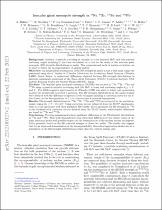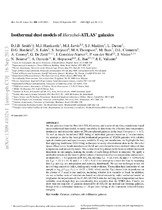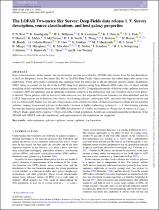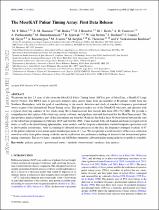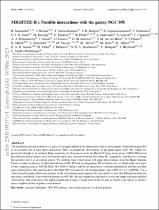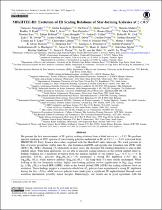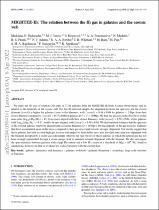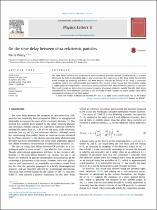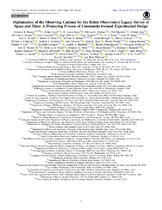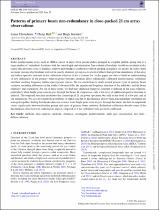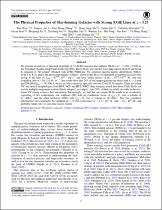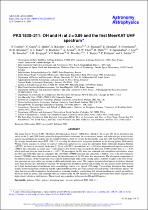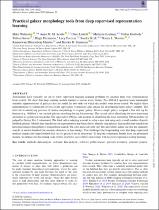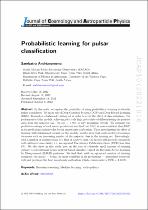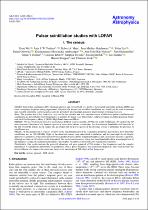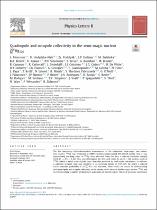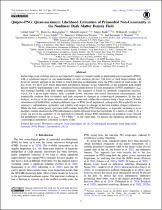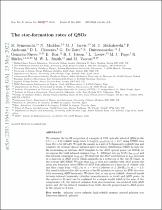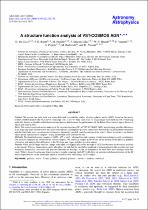Browsing Research Articles (Physics) by Subject "Astrophysics"
Now showing items 21-40 of 43
-
Isoscalar giant monopole strength in 58Ni, 90Zr, 120Sn and 208Pb
(American Physical Society, 2023)Inelastic α-particle scattering at energies of a few hundred MeV and very-forward scattering angles including 0° has been established as a tool for the study of the isoscalar giant monopole (IS0) strength distributions ... -
Isothermal dust models of Herschel-ATLAS galaxies
(Oxford University Press, 2013)We use galaxies from the Herschel-ATLAS survey, and a suite of ancillary simulations based on an isothermal dust model, to study our ability to determine the effective dust temperature, luminosity and emissivity index of ... -
The lofar two-metre sky survey: Deep fields data release 1. V. Survey description, source classifications, and host galaxy properties
(Oxford University Press, 2023)Source classifications, stellar masses, and star-formation rates are presented for ≈80 000 radio sources from the first data release of the Low Frequency Array Two-metre Sky Survey (LoTSS) Deep Fields, which represents the ... -
The MeerKAT pulsar timing array: First data release
(Oxford University Press, 2022)We present the first 2.5 years of data from the MeerKAT Pulsar Timing Array (MPTA), part of MeerTime, a MeerKAT Large Survey Project. The MPTA aims to precisely measure pulse arrival times from an ensemble of 88 pulsars ... -
Mightee-h i: Possible interactions with the galaxy NGC 895
(Oxford University Press, 2023)The transformation and evolution of a galaxy is strongly influenced by interactions with its environment. Neutral hydrogen (H i) is an excellent way to trace these interactions. Here, we present H i observations of the ... -
Mightee-hi: Evolution of hi scaling relations of star-forming galaxies at z < 0.5*
(IOP Publishing, 2022)We present the first measurements of H I galaxy scaling relations from a blind survey at z > 0.15. We perform spectral stacking of 9023 spectra of star-forming galaxies undetected in H I at 0.23 < z < 0.49, extracted ... -
MIGHTEE-Hi: The relation between the Hi gas in galaxies and the cosmic web
(Oxford University Press, 2022)We study the 3D axis of rotation (3D spin) of 77 Hi galaxies from the MIGHTEE-Hi Early Science observations, and its relation to the filaments of the cosmic web. For this Hi-selected sample, the alignment between the spin ... -
On the primordial origin of the smoothing excess in the Planck temperature power spectrum in light of LSS data
(IOP Publishing, 2022)The Planck DR3 measurements of the temperature and polarization anisotropies power spectra of the cosmic microwave background (CMB) show an excess of smoothing of the acoustic peaks with respect to ΛCDM, often quantified ... -
On the time delay between ultra-relativistic particles
(Elsevier, 2016)The time delay between the receptions of ultra-relativistic particles emitted simultaneously is a useful observable for both fundamental physics and cosmology. The expression of the delay when the particles travel through ... -
Optimization of the observing cadence for the Rubin observatory legacy survey of space and time: A pioneering process of community-focused experimental design
(IOP Publishing, 2022)Vera C. Rubin Observatory is a ground-based astronomical facility under construction, a joint project of the National Science Foundation and the U.S. Department of Energy, designed to conduct a multipurpose 10 yr ... -
Patterns of primary beam non-redundancy in close-packed 21 cm array observations
(Oxford University Press, 2021)Radio interferometer arrays such as HERA consist of many close-packed dishes arranged in a regular pattern, giving rise to a large number of ‘redundant’ baselines with the same length and orientation. Since identical ... -
The physical properties of star-forming galaxies with strong [oiii]lines at z=3.25
(IOP Publishing, 2022)We present an analysis of physical properties of 34 [O III] emission-line galaxies (ELGs) at z = 3.254 ± 0.029 in the Extended Chandra Deep Field South (ECDFS). These ELGs are selected from deep narrow H2S(1) and broad Ks ... -
Pks 1830-211: oh and hi at z = 0.89 and the first meerkat uhf spectrum
(EDP Sciences, 2021)The Large Survey Project (LSP) "MeerKAT Absorption Line Survey"(MALS) is a blind H I 21 cm and OH 18 cm absorption line survey in the L- and UHF-bands, primarily designed to better determine the occurrence of atomic and ... -
Practical galaxy morphology tools from deep supervised representation learning
(Oxford University Press, 2022)Astronomers have typically set out to solve supervised machine learning problems by creating their own representations from scratch. We show that deep learning models trained to answer every Galaxy Zoo DECaLS question ... -
Probabilistic learning for pulsar classification
(IOP Publishing, 2022)In this work, we explore the possibility of using probabilistic learning to identify pulsar candidates. We make use of Deep Gaussian Process (DGP) and Deep Kernel Learning (DKL). Trained on a balanced training set in ... -
Pulsar scintillation studies with LOFAR I. The census
(Hans Publishers, 2022)Interstellar scintillation (ISS) of pulsar emission can be used both as a probe of the ionized interstellar medium (IISM) and cause corruptions in pulsar timing experiments. Of particular interest are so-called scintillation ... -
Quadrupole and octupole collectivity in the semi-magic nucleus 80206Hg126
(Elsevier, 2023)The first low-energy Coulomb-excitation measurement of the radioactive, semi-magic, two proton-hole nucleus 206Hg, was performed at CERN's recently-commissioned HIE-ISOLDE facility. Two γ rays depopulating low-lying states ... -
Quijote-png: Quasi-maximum likelihood estimation of primordial non-gaussianity in the nonlinear dark matter density field
(American Astronomical Society, 2022)Future large-scale structure surveys are expected to improve current bounds on primordial non-Gaussianity (PNG), with a significant impact on our understanding of early universe physics. The level of such improvements ... -
The star formation rates of QSOs
(Royal Astronomical Society, 2022)We examine the far-IR properties of a sample of 5391 optically selected QSOs in the 0.5 < z < 2.65 redshift range down to log [νLν,2500(erg/s)] > 44.7, using SPIRE data from Herschel-ATLAS. We split the sample in a grid ... -
A structure function analysis of vst-cosmos agn
(EDP Sciences, 2022)We present our sixth work in a series dedicated to variability studies of active galactic nuclei (AGN), based on the survey of the COSMOS field by the VLT Survey Telescope (VST). Its 54 r-band visits over 3.3 yr and ...

